Good Intentions
“Back in her room he said, “Didn’t have no apples. He said this was a good pear.”
East of Eden, John Steinbeck
Inspiration
One of the things I intend to do each year is to bake recipes I haven’t tried before. I’ve had this recipe from The Fannie Farmer Baking Book on my list to try for years and decided it would be my first good intention of this year. This quote from Marion Cunningham always captures my imagination. “Not truly a tart, but a wonderful creation! The yellow cornmeal crust covers pear halves, which make little hills all over. This is an outstanding recipe in every way.” The line drawings of the tart with hills made of pears are just as scrumptious as the recipe description. Just in case there were any thoughts about the worthiness of this recipe. Mr R said he could eat this tart all day long. That is quite a statement since there is absolutely no chocolate in the recipe.
I used Bosc pears, although any ripe pear would be wonderful in this recipe. Don’t be dissuaded by the dusky golden brown exterior of a Bosc. This pear has terrific flavor with firm flesh, perfect for baking. Determining the ripeness of the Bosc is like searching for clues in a detective story. Pears are unique in that they continue to ripen after harvest. The ripeness is determined at the very smallest part of the fruit— by the stem. When a pear is ripe this is the part of the fruit that softens. Waiting for the entire fruit to become soft leads to a mushy pear. My Boscs never really became soft at the stem area, rather the skin ever so slightly began to shrivel, while the body of the pear remained firm. It was then that this fantastic tart was made.
Essentials
I don’t have any idea how Rick O’Connell developed this recipe or how Marion Cunningham came upon it but I will make it again. I want to try the poaching liquid with red wine instead of white. I imagine the color contrast between the sunny yellow dough and the ruby red pears would be a stunner. There are two separate parts to this recipe, the pears and the tart dough. The pear preparation can be done the day before making the tart by keeping them in the poaching liquid in the refrigerator overnight. An overnight soak will lead to more intensely flavored pears. Once the pears are ready the tart comes together quickly as the dough does not require chilling. The recipe clearly states the dough should be rolled out between two sheets of waxed paper, but of course I ignored the instructions. I was especially cavalier about the crust since the dough could be pieced together without any adverse outcome. Proceed at your own peril as Marion Cunningham’s recipes are very close to flawless (which is why I make them) and her instructions are meant to be followed.
I did find the original recipe for the Pear and Polenta Tart online. Since I made so many changes to the original, I’ve included my adaptation below. I used a ten inch tart pan with a removable bottom and five pears filled my pan. The number of pears needed for the tart will depend on the size of the pan and pears. I added more spices—ginger, star anise and a juicy vanilla bean to the original recipe and then reduced the poaching liquid until it was a thick syrup, stirring in candied ginger. All this lovely sweet sauce, brimming with the warming spices of winter, is scooped in between the poached pears just before baking. Replacing half of the cornmeal with semolina flour kept the crust a sunny yellow while reducing the grittiness of the tart dough.
| Pears and their Spiced Sauce | |
| 1/2C | sugar |
| 1” | piece of fresh ginger peeled and sliced into coins |
| 1 | vanilla bean, split open |
| 2 | small cinnamon sticks |
| 4 | star anise |
| 1C | white wine |
| 3C | water |
| 5-6 | firm, yet ripe pears |
| 2T | finely minced candied ginger |
| Tart Dough | |
| 3 | egg yolks |
| 2-3T | cold water |
| 2C | all-purpose flour |
| 1/2C | finely ground cornmeal |
| 1/2C | semolina flour |
| 2/3C | sugar |
| 1/2t | fine grain sea salt |
| 1C | unsalted butter, chilled |
- In a pan large enough hold the pear halves in a single layer add the sugar, ginger slices, vanilla bean, cinnamon sticks, star anise, white wine and water. Bring the mixture to a boil and turn down to a low simmer. While the poaching liquid simmers and the sugar dissolves, peel the pears. Cut them in half lengthwise and remove the cores. (A melon baller will perfectly remove the cores.) Place the pears flat side down in the poaching liquid and add enough water to cover them completely. Heat the liquid to a low simmer, but not bubbling, and poach the pears until they can be easily pierced with a knife, about fifteen minutes. Remove the pan from the heat and let the pears cool in the liquid until room temperature. When cool move the pears from the pan to a cooling rack set on top of a sheet pan with sides to drain while making the spiced sauce and tart dough.
- Return the pan back to the stove and bring the poaching liquid, spices and vanilla bean to a vigorous boil. When the liquid is reduced down to 1/4” in the bottom of the pan remove the spices and vanilla bean. Turn the heat down a bit and continue to simmer until the liquid is fragrant and sticky and the sauce that remains thickly coats the bottom of the pan. As the liquid reduces it will need more watching. Take care that it does not burn. Remove from heat and stir in the candied ginger.
- Heat the oven to 375 °. In a small bowl mix the egg yolks with 2 tablespoons of cold water. In the bowl of a food processor add the flour, cornmeal, semolina, sugar and salt. Pulse to combine. Cut the butter into chunks and add to the food processor. Pulse until no large chunks of butter remain. With the processor running pour the egg mixture through the feed tube. If the dough does not come together add another tablespoon of water, a teaspoon at a time. Turn the dough out onto a lightly floured work surface. Bring it together into a ball and then divide it into two rounds.
- With a floured rolling pin on a lightly floured work surface roll one piece of dough in a circular shape that is larger than the diameter of the tart pan and approximately 1/4” thick. Fold the circle of dough in half or quarters and transfer to the tart pan. Center the dough in the middle of the tart pan. Unfold the dough back into a circle. Gently push the dough down into the contours of the tart pan without stretching the dough. Trim the dough flush with the edge of the tart pan. Patch any cracks or tears with the trimmed dough. (For less tearing and patching, and per the original recipe, roll the dough out between two sheets of waxed paper that have been dusted with flour.) Place the cooled pears flat side down, in a single layer, in a circle around the edge of the tart pan by placing the stem side, or narrow end, of the pears facing the center of the tart. Place another pear(s) in the center of the pan. Scoop the cooled spiced sauce around the pears. If it is too stiff to spread, warm just until it can be scooped. Roll out the second piece of dough, fold it half and transfer it to the tart pan. Unfold the dough back in a circle, centering in the middle of the tart pan. Trim the edges of the dough flush with the edge of the pan and seal the edges of the crust by pressing them firmly together.
- Bake the tart for 35-40 minutes until the edges have turned a toasty brown and the crust has pulled away from the outer edges of the pan. Let cool completely before removing the tart ring and cutting.

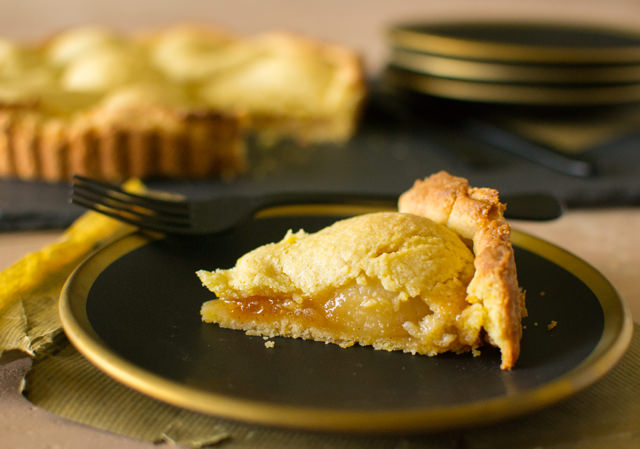
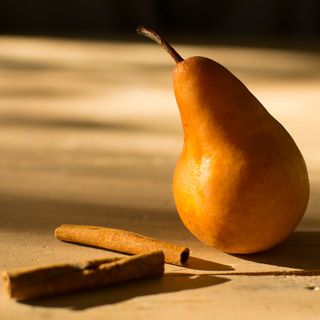
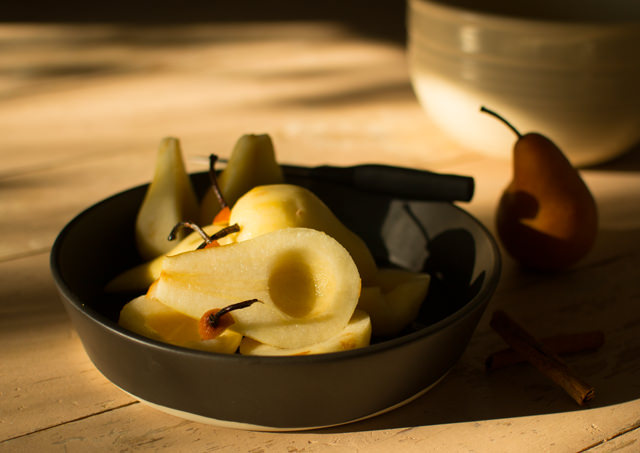
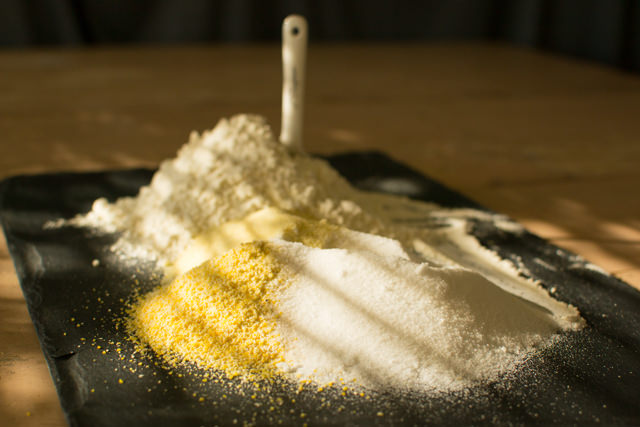
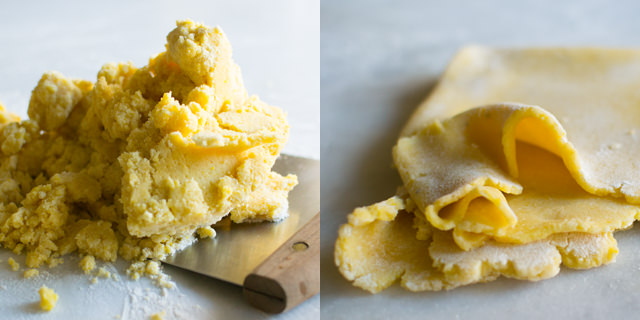
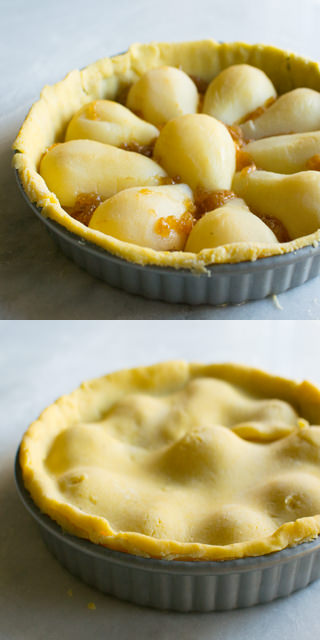
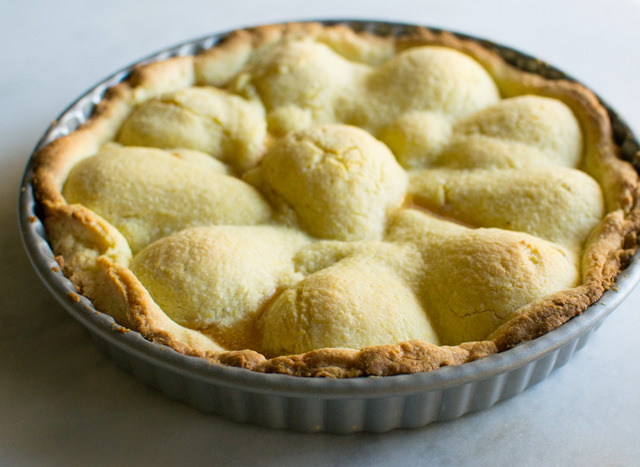
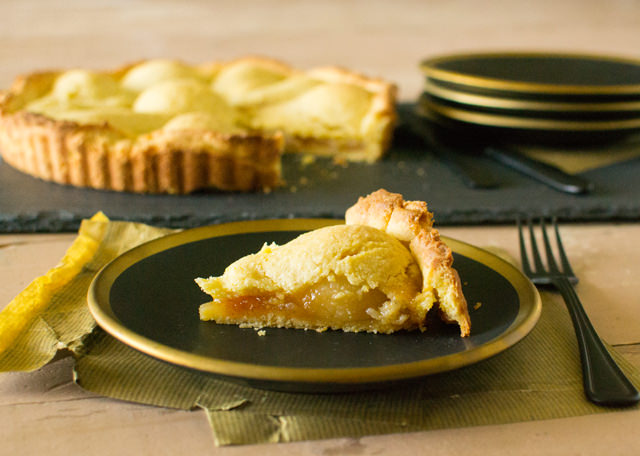
Well this caught my eye because I’m poaching pears for a dessert tomorrow. I love the elegance of this tart — how the crust lays over the pears. Bosc are my favorite to bake with. I can imagine I would also look forward to eating this tart “all day long” as Mr. B said 😉 Gorgeous!
Thank you Kelly! Bosc’s are wonderful, aren’t they?
It looks so golden and warm Deb x
Oh Deena, if you enjoy pears, this is a fabulous recipe! Thank you for commenting!
i absolutely love everything about this recipe: the look of it, the spiced pears, the crust…all of it looks like it works SO well, and i’m totally in a fruit mood recently. And there’s nothing which would dissuade me from Boscs…i love them, and their beautiful burnished exterior. They look like little antiques to me and i love that – like they belong in a still life from the 1700’s. 🙂 Beautiful work, Deb.
What a lovely comment! Thank you so very much Shannon!
I love the top of this tart! I too have the Fannie Farmer cookbook… it was my dad’s prized cooking guide in his single days 🙂
Thank you Medha! I wish more of the cookbooks in my collection had recipes that we’re as good as the ones from Fannie Farmer!
I love the yellow of the dough and those pretty pear hills! The poaching liquid sounds delicious too. Sounds like a recipe to return to often!
Thank you Lisa!
I always think it feels so good to make a recipe I’ve had on file in my mind for a long time. This looks so delicious! Bosc pears are my favorite and the image with the shadows is so, so pretty!
Thank you for the wonderful comment Valentina!
The hue of your photos is so lovely Deb. My son has become quite the tart maker in the last month in between semesters. I will forward him this link right away. Love the idea of using polenta and semolina. I hope your year is off to a good and delicious start.
Thank you for your lovely comment Beth! This is a great tart recipe as the crust does not require chilling and does not become tough when pieced together. I hope your son enjoys the recipe!
This tart looks like absolute perfection! So refined, so beautiful.
Thank you for the gracious comment Viviane!
What a stunning post , I’m always impressed . We used to have a pear tree on our farm in Germany with small pears that were put on racks in the cellar for the winter. By Cristmas they were all shriveled up and had to be peeled before one could eat them. I have never seen and tasted pears like that again (nobody would buy them today because they were ugly) . They were the juiciest sweetest pears I ever tasted in my life. Your tart looks wonderful. I like the crust and the addition of ginger to the pears.
Thank you so much for sharing your wonderful comment Gerlinde! Your description of the winter pears is lovely. I only wish I had one to try!
Deb, what a beautiful tart! Your photo of the pears in the tart pan would make for a lovely still life painting. Pears and polenta make for happy ‘tart fellows’.
Oh Mary your gracious comment has brightened my day! Thank you for your kindness.
I love bosc pears, what a sumptuous tart!
Thank you Laura!
This is so lovely and perfect for my Bug, a peerless pear lover. Gorgeous photos as always, too!
Thank you for the delicious comment Carol! If you enjoy fruit desserts, especially pears, this is a must make recipe.
What a beautiful tart! Bosc are the best of all pears and, from what I’ve found the best for poaching. They don’t get mushy. I do love it that the pears are marinated overnight before making the tart. I would love a slice of this tart!
You’re correct MJ, the Bosc pears did not become mushy which is the perfect quality for this tart. Thank you for the wonderful comment!
This already looks gorgeous but you’re right – I bet if you used red wine it would really just take it over the top. The changes you made sound amazing – I would love to come over and have this for dessert 🙂
Thank you Natalie! If your enjoy pears, this is a must make recipe!
Anything with polenta is my cup of tea. It is refreshing to know that you are one of those people who try new dishes. I am too! This tart not only looks beautiful but also sounds quite delicious!
Thank you for the wonderful comment Denise, much appreciated!